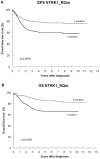Clinical significance of NTRK family gene expression in neuroblastomas
- PMID: 21990266
- PMCID: PMC3258457
- DOI: 10.1002/pbc.23343
Clinical significance of NTRK family gene expression in neuroblastomas
Abstract
Background: Neuroblastomas (NBs) are characterized by clinical heterogeneity, from spontaneous regression to relentless progression. The pattern of NTRK family gene expression contributes to these disparate behaviors. TrkA/NTRK1 is expressed in favorable NBs that regress or differentiate, whereas TrkB/NTRK2 and its ligand brain-derived neurotrophic factor (BDNF) are co-expressed in unfavorable NBs, representing an autocrine survival pathway. We determined the significance of NTRK family gene expression in a large, representative set of primary NBs.
Patients and methods: We analyzed the expression of the following genes in 814 NBs using quantitative real-time reverse transcriptase polymerase chain reaction (RT-PCR): NTRK1, NTRK2, NTRK3, P75/NGFR, nerve growth factor (NGF), BDNF, IGFR1, and EGFR. Expression (high vs. low) was dichotomized by median expression value and compared to clinical and biological variables as well as outcome.
Results: High NTRK1 expression was strongly correlated with favorable age, stage, MYCN status, histology, ploidy, risk group, and outcome (P < 0.0001 for all). However, it did not add significantly to the panel of prognostic variables currently used for cooperative group trials. NTRK2 expression was associated with risk factors but not with outcome. High NGF expression was also associated with most risk factors and weakly with unfavorable outcome.
Conclusions: High expression of NTRK1 is strongly associated with favorable risk factors and outcome in a large, representative population of NB patients. It did not add significantly to the current risk prediction algorithm, but it may contribute to future expression classifiers. Indeed, prospective assessment of NTRK1 and NTRK2 expression will identify tumors that would be candidates for NTRK-targeted therapy, either alone or in combination with conventional agents.
Copyright © 2011 Wiley Periodicals, Inc.
Conflict of interest statement
None of the authors have any conflicting financial interests with any of the material, data, results or conclusions in this manuscript.
Similar articles
-
Prognostic impact of MYCN, DDX1, TrkA, and TrkC gene transcripts expression in neuroblastoma.Pediatr Blood Cancer. 2011 May;56(5):749-56. doi: 10.1002/pbc.22823. Epub 2010 Dec 9. Pediatr Blood Cancer. 2011. PMID: 21154590
-
Prognostic and biological role of neurotrophin-receptor TrkA and TrkB in neuroblastoma.Klin Padiatr. 2000 Jul-Aug;212(4):200-5. doi: 10.1055/s-2000-9677. Klin Padiatr. 2000. PMID: 10994551
-
c.1810C>T polymorphism of NTRK1 gene is associated with reduced survival in neuroblastoma patients.BMC Cancer. 2009 Dec 13;9:436. doi: 10.1186/1471-2407-9-436. BMC Cancer. 2009. PMID: 20003389 Free PMC article.
-
Expression of a MYCN-interacting isoform of the tumor suppressor BIN1 is reduced in neuroblastomas with unfavorable biological features.Clin Cancer Res. 2003 Aug 15;9(9):3345-55. Clin Cancer Res. 2003. PMID: 12960121
-
The oncogenic roles of NTRK fusions and methods of molecular diagnosis.Cancer Genet. 2021 Nov;258-259:110-119. doi: 10.1016/j.cancergen.2021.10.005. Epub 2021 Oct 18. Cancer Genet. 2021. PMID: 34710798 Review.
Cited by
-
Neuroblastoma tyrosine kinase signaling networks involve FYN and LYN in endosomes and lipid rafts.PLoS Comput Biol. 2015 Apr 17;11(4):e1004130. doi: 10.1371/journal.pcbi.1004130. eCollection 2015 Apr. PLoS Comput Biol. 2015. PMID: 25884760 Free PMC article.
-
Methylation and expression patterns of tropomyosin-related kinase genes in different grades of glioma.Neuromolecular Med. 2014 Sep;16(3):529-39. doi: 10.1007/s12017-014-8303-0. Epub 2014 May 20. Neuromolecular Med. 2014. Retraction in: Neuromolecular Med. 2021 Dec;23(4):576. doi: 10.1007/s12017-021-08682-y. PMID: 24840578 Retracted.
-
ASCL1 phosphorylation and ID2 upregulation are roadblocks to glioblastoma stem cell differentiation.Sci Rep. 2022 Feb 11;12(1):2341. doi: 10.1038/s41598-022-06248-x. Sci Rep. 2022. PMID: 35149717 Free PMC article.
-
A Potential Prognostic Gene Signature Associated with p53-Dependent NTRK1 Activation and Increased Survival of Neuroblastoma Patients.Cancers (Basel). 2024 Feb 8;16(4):722. doi: 10.3390/cancers16040722. Cancers (Basel). 2024. PMID: 38398114 Free PMC article.
-
Epigallocatechin-3-gallate and 6-OH-11-O-Hydroxyphenanthrene Limit BE(2)-C Neuroblastoma Cell Growth and Neurosphere Formation In Vitro.Nutrients. 2018 Aug 22;10(9):1141. doi: 10.3390/nu10091141. Nutrients. 2018. PMID: 30135355 Free PMC article.
References
-
- Brodeur GM, Hogarty MD, Mosse YP, et al. Neuroblastoma. In: Pizzo PA, Poplack DG, editors. Principles and Practice of Pediatric Oncology. 6. Philadelphia: Lippincott, Williams and Wilkins; 2011. pp. 886–922.
-
- Brodeur GM. Neuroblastoma: biological insights into a clinical enigma. Nat Rev Cancer. 2003;3(3):203–216. - PubMed
-
- Nakagawara A, Arima M, Azar CG, et al. Inverse relationship between trk expression and N-myc amplification in human neuroblastomas. Cancer Res. 1992;52(5):1364–1368. - PubMed
Publication types
MeSH terms
Substances
Grants and funding
LinkOut - more resources
Full Text Sources
Other Literature Sources
Medical
Research Materials
Miscellaneous



